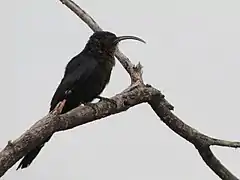| Rhinopomastus[1] | |||
| Jardine, 1828[2] | |||
 Przedstawiciel rodzaju – czarnodudek większy (R. cyanomelas) | |||
| Systematyka | |||
| Domena | |||
|---|---|---|---|
| Królestwo | |||
| Typ | |||
| Podtyp | |||
| Gromada | |||
| Podgromada | |||
| Infragromada | |||
| Rząd | |||
| Rodzina | |||
| Rodzaj |
Rhinopomastus | ||
| Typ nomenklatoryczny | |||
|
Rhinopomastus smithii Jardine, 1828 (= Falcinellus cyanomelas Vieillot, 1819) | |||
| Synonimy | |||
|
| |||
| Gatunki | |||
| |||
Rhinopomastus – rodzaj ptaków z rodziny sierpodudków (Phoeniculidae).
Zasięg występowania
Morfologia
Długość ciała 21–30 cm; masa ciała 18–38,8 g[5].
Systematyka
Etymologia
- Rhinopomastus: gr. ῥις rhis, ῥινος rhinos „nozdrza”; πωμα pōma, πωματος pōmatos „pokrywa”[6].
- Scoptelus: gr. σκωπτηλος skōptēlos „przedrzeźniacz”, od σκωπτω skōptō „przedrzeźniać”[7]. Gatunek typowy: Promerops aterrimus J.F. Stephens, 1826.
- Iridoptilus: gr. ιρις iris, ιριδος iridos „tęcza, iryzacja”; πτιλον ptilon „upierzenie, pióro”[8]. Gatunek typowy: Promerops pusillus Swainson, 1837 (= Promerops aterrimus J.F. Stephens, 1826).
Podział systematyczny
Do rodzaju należą następujące gatunki[9]:
- Rhinopomastus aterrimus (Stephens, 1826) – czarnodudek ciemnodzioby
- Rhinopomastus cyanomelas (Vieillot, 1819) – czarnodudek większy
- Rhinopomastus minor (Rüppell, 1845) – czarnodudek czerwonodzioby
Przypisy
- ↑ Rhinopomastus, [w:] Integrated Taxonomic Information System (ang.).
- ↑ W. Jardine. Observations on Rhinopomastus of Dr. Smith, a new Genus among the Promeropidæ. „The Zoological Journal”. 4, s. 1, 2, ryc. 1, 1828. (ang.).
- ↑ J. Cabanis & F. Heine: Museum Heineanum: Verzeichniss der ornithologischen Sammlung des Oberamtmann Ferdinand Heine, auf Gut St. Burchard vor Halberstadt. T. 2: Schreivögel. Halberstadt: In Commission bei R. Frantz, 1859–1860, s. 129. (niem.).
- ↑ L.J.F.J. Fitzinger. Über das System und die Charakteristik der natürlichen Familien der Vögel. „Sitzungsberichte der Kaiserlichen Akademie der Wissenschaften. Mathematisch-Naturwissenschaftliche Classe”. 46 (1), s. 226, 1863. (niem.).
- 1 2 D.W. Winkler, S.M. Billerman & I.J. Lovette: Woodhoopoes and Scimitarbills (Phoeniculidae), version 1.0. W: S.M. Billerman, B.K. Keeney, P.G. Rodewald & T.S. Schulenberg (red.): Birds of the World. Ithaca, NY: Cornell Lab of Ornithology, 2020. DOI: 10.2173/bow.phoeni2.01. [dostęp 2020-06-17]. (ang.).

- ↑ Rhinopomastus, [w:] The Key to Scientific Names, J.A. Jobling (red.), [w:] Birds of the World, S.M. Billerman et al. (red.), Cornell Lab of Ornithology, Ithaca [dostęp 2022-01-22] (ang.).
- ↑ Scoptelus, [w:] The Key to Scientific Names, J.A. Jobling (red.), [w:] Birds of the World, S.M. Billerman et al. (red.), Cornell Lab of Ornithology, Ithaca [dostęp 2022-01-22] (ang.).
- ↑ Iridoptilus, [w:] The Key to Scientific Names, J.A. Jobling (red.), [w:] Birds of the World, S.M. Billerman et al. (red.), Cornell Lab of Ornithology, Ithaca [dostęp 2022-01-22] (ang.).
- ↑ Systematyka i nazwy polskie za: P. Mielczarek & M. Kuziemko: Rodzina: Phoeniculidae Bonaparte, 1831 - sierpodudki - Wood-hoopoes (Wersja: 2021-01-16). [w:] Kompletna lista ptaków świata [on-line]. Instytut Nauk o Środowisku Uniwersytetu Jagiellońskiego. [dostęp 2022-01-22].
This article is issued from Wikipedia. The text is licensed under Creative Commons - Attribution - Sharealike. Additional terms may apply for the media files.